Australia
S to Z of Surfing Vehicles Dude
“Surfs up!”
“Dude, how am I gonna get there?”
“Bro, you need a car!”

Summer is here, and surfing is a great lifestyle for getting out, chasing the waves, and getting some immunity-boosting Vitamin D. In fact, any sort of outdoor adventure and exercise will see you a fitter and healthier person for getting out there and doing it. What 2022 cars make for an ideal surfer’s or outdoorsy-person’s companion? The following are several useful vehicles that will transport you, a friend or two, some gear, and surfboards/mountain bikes through something more than just a little puddle, mud or soft sand.
Dedicated vans or MPVs with AWD like the Volkswagen Multivan, LDV G10, Mercedes-Benz V-Class, Kia Carnival, Mercedes-Benz Valente, Volkswagen Caravelle, Honda Odyssey, Hyundai STARIA, Volkswagen California, Toyota Granvia, Mercedes-Benz Marco Polo ACTIVITY, and the Volkswagen Caddy are potentially great for surfing travels with one, two or more mates. Some, but not all, will offer AWD. Depending on how far down onto the beach you want to get your MPV or Van, AWD is definitely the way to go for ensuring you have a better chance of getting through soft sand and out of sticky situations.
For years, station wagons have been a go-to machine for the surfer; for good reason too as they offer plenty of space for lugging gear and for sleeping. Having a vehicle that can get you across country and down onto the beach makes for the ultimate surfer’s vehicle. Outside of the list of MPVs/vans above, there are some great vehicles worth a look if you’re into doing a bit of surfing, fishing and any other type of outdoor adventure.
Here is the best of them from S (Skoda) to V (Volvo). Let us know if we’ve missed anything in between!
Skoda Kodiaq
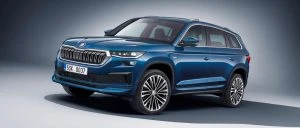
Arguably the best in the business is Skoda’s Kodiaq. It does everything a surfer wants very well. The 2.0-litre Turbo petrol engine is smooth and powerful. 4×4 capability is at the ready, and the Kodiaq Wagon boasts 7-seats and a 7 speed automatic 4×4 gearbox. A 132 kW/320 Nm turbo-petrol is under the bonnet of the base and Sportline variants. The punchy RS packs a 176 kW/500 Nm version of the 2.0-litre engine. The AWD-only Skoda not only offers 3 rows of seats, it is also able to open up 2005 litres of boot space. With standard autonomous emergency braking, adaptive cruise control, a seven-speed dual-clutch gearbox, active LED headlights and a cosy, suede-trimmed interior complete with sat-nav, keyless start, two-zone climate-control and side and rear-window blinds, the Skoda Kodiaq is one very impressive package.
Skoda Superb AWD Scout
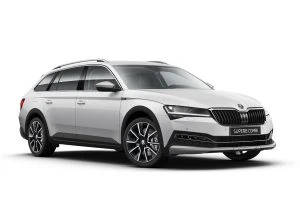
Grab yourself an AWD Skoda Superb Scout crossover wagon and surfing trips just got a whole lot nicer. Under the Scout’s bonnet sits a 200 kW/350 Nm, 2.0-litre turbo petrol engine with a seven-speed dual-clutch gearbox. The spacious, comfortable and high-quality cabin is laden with plenty of soft-touch panels and easy-to-read interfaces. Safety technology includes front and rear autonomous emergency braking, rear cross-traffic alert, lane departure warning with active assist, blind-spot monitoring and self-parking. The Superb Wagons will take 660 litres of luggage, expanding to 1950 litres with the rear seats folded. Towing capacity is rated at 2.2 tonnes.
SsangYong Rexton
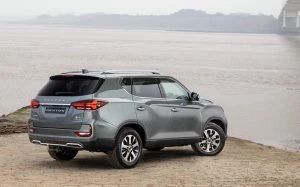
Here’s another strong contender for best surfing wagon. The seven-seater, five-star safe, 8-speed auto, 4×4, 2.2 Diesel-Turbo SsangYong Rexton large SUV uses a 149 kW/441 Nm 2.2-litre turbo-diesel that boasts less than 9 litres/100 km fuel economy. With, all-independent suspension, all-wheel disc brakes and an eight-speed auto gearbox, the big Korean-made SUV is equipped to go bush. Boot space is a handy 1806 litres with second and third rows flat.
Subaru Forester
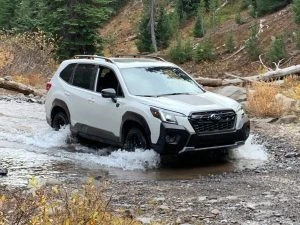
An icon in the surfing fraternity, the Subaru Forester always delivers the goods. 2022 sees the 5-door wagon offer a CVT 7-speed AWD with even autonomous emergency steering standard. This is five-star safe, great on sipping small amounts of fuel and comfortable on any surface of road. The Forester continues with the 136 kW/239 Nm 2.5-litre four-cylinder boxer engine, and the 2.0-litre mild-hybrid claims 6- to 7 litres/100 km. The Forester offers generous levels of passenger space, and the luggage capacity can open to 1768 litres with the rear seats folded. Of course, the Forester is known for going places that Physics suggest it shouldn’t. It is capable off-road, just keep in mind that it’s not a “Landie”!
Subaru Outback
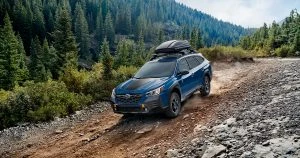
Surprise, surprise, here is another Subaru, and a favourite with surfers. The latest Subaru Outback is the newest of a long line of wagon’s that have carried surfboards and surfers all around the country. Subaru’s Outback is made for the surfer’s design brief, so it will happily go off-road, cruise the open road, accommodate a mattress and provide great accident protection. Five-star safe and comfortable to drive, the 5-door Outback Wagon uses a 138 kW/245 Nm 2.5-litre boxer petrol four-cylinder driving all four wheels through a new CVT transmission. Subaru’s Outback crossover is bigger inside and out, employs the company’s latest global platform and features all the latest safety technology. You can tow up to two-tonnes, and you have a boot with up to 2144 litres!
Toyota
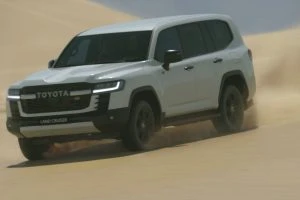
Plenty of choice in the Toyota brand. Take your pick out of the RAV4 (smallest), Kluger, Fortuner, Prado (largest), and Land Cruiser. All will get you far and beyond the tarmac, the Prado and Land Cruiser being truly 4×4 bush bashing capable. Comfortable, reliable, and safe. Boot space starts at around 1800 litres for the RAV4 and gets bigger from here.
Volkswagen Touareg
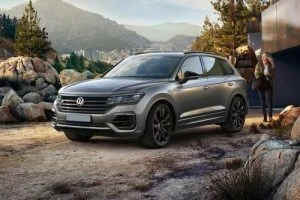
Good things come from VW, as surfers well know – the VW Kombi being a surfing icon. Well-dressed, big and brutish is what many of the ladies like, and the Volkswagen Touareg has it all. Available as a huge 5-door SUV shape, the Touareg boasts five-star safety, 4×4 competence, and a huge boot (over 1800 litres). Passenger space is right up there with the best in the business. It is available with a choice of three diesel engines: two 3.0-litre V6s – 170 kW/500 Nm (170 TDI) and 210 kW/600 Nm (210 TDI), plus a ruthless 310 kW/900 Nm 4.0-litre twin-turbo V8 monster.
VW Tiguan Allspace
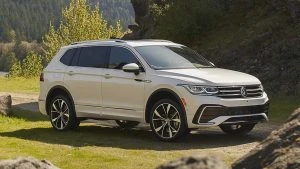
Over 2000 litres of boot space (Allspace version), a practical no-nonsense interior, 5-star safe, comfortable to drive, AWD availability, and the Tiguan starts to make sense. It is also another vehicle that has self-parking capability. With 4MOTION AWD and a dual-clutch six or seven-speed auto transmissions, the Tiguan is an impressive mid-size SUV. The choice of motors is good; a 110 kW/250 Nm 1.4-litre and 162 kW/350 Nm 2.0-litre petrol turbo is available along with the torquey and thrifty 147 TDI 147 kW/400 Nm turbo-diesel.
Volvo XC60
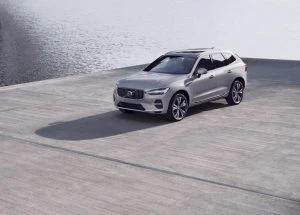
Volvos are amazing cars to drive. They are so comfortable, elegant, and boast all the best tech. Safety is a given, and the XC60 has up to 1792 litres of boot space. Five-door SUV styling, an 8-speed automatic with AWD and you’re away. Volvo’s XC60 SUV line-up is powered by petrol-only mild-hybrid 2.0-litre four-cylinder engines. The R-Design continues with the more powerful 220 kW/420 Nm B6 mild-hybrid powertrain while the Polestar Engineered sticks with the 311 kW/670 Nm T8 Twin Engine plug-in hybrid powertrain. Both are nice and responsive engines.
Volvo XC90
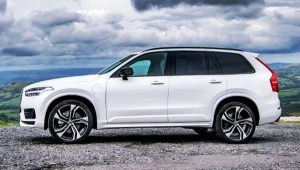
Even with all 7 seats in place, the Volvo XC90 boot can hold up to 302 litres of luggage. Folding down second and third rows makes way for 1856 litres. A superbly comfortable, AWD capable, and delivering huge safety credentials, the new Volvo XC90 is a luxury SUV like no other. All XC90s come with autonomous emergency braking, adaptive cruise control, lane-departure warning/assist, sat-nav, self-parking, AWD, an 8-speed automatic transmission and a fuel-saving idle-stop system. The XC90 D4 is powered by a 173 kW/480 Nm 2.0-litre four-cylinder turbo-diesel. The T6 petrol comes with a 140 kW/400 Nm 2.0-litre four-cylinder turbo-diesel. The 2.0-litre plug-in petrol-electric hybrid XC90 T8 claims an amazing 2.1 litres/100 km fuel consumption and slingshots to 100 km/h in 5.5 seconds!
K to R of Surfing Vehicles Dude
“Surfs up!”
“Dude, how am I gonna get there?”
“Bro, you need a car!”

Summer is here, and surfing is a great lifestyle for getting out, chasing the waves, and getting some immunity-boosting Vitamin D. In fact, any sort of outdoor adventure and exercise will see you a fitter and healthier person for getting out there and doing it. What 2022 cars make for an ideal surfer’s companion? The following are several useful vehicles that, if you’re wanting something to get you places, will transport you, a friend or two, some gear, and surfboards/mountain bikes through something more than just a little puddle, mud or soft sand.
Dedicated vans with AWD or MPVs are potentially great for surfing travels with one, two or more mates. Some, but not all, will offer AWD. Depending on how far down onto the beach you want to get your MPV or Van, AWD is definitely the way to go for getting through soft sand and sticky situations. Having a vehicle that can get you across country and down onto the beach makes for the ultimate surfer’s vehicle.
There are some very good vehicles worth a look if you’re into doing a bit of surfing, fishing and any outdoor adventure. Aside from an AWD Van or AWD MPV, here are the best of them from K (Kia) to R (Renault). Let us know if we’ve missed anything in between!
Kia Sorento

The seven-seat Kia Sorento SUV is one of the most advanced vehicles in its class. If you find parking a mean trick, then it can even park itself without anyone inside. Quiet, roomy and with a large boot, the Sorento is available in Sport, Sport+ and GT-Line and the choice of a front-drive 3.5-litre 200 kW/332 Nm V6 petrol with an eight-speed auto gearbox, an AWD dual-clutch auto 148 kW/440 Nm 2.2-litre four-cylinder turbo-diesel or a 190 kW/350 Nm PHEV. The roomy cabin is enhanced by a commodious 616-litre boot that increases to a massive, all-seats-folded 2011 litres.
Land Rover Defender

Ultimate 4×4 traction. The 2.0-litre D200, D240 and D250 diesels produce 147 kW/430 Nm, 177 kW/430 Nm and 183 kW/570 Nm respectively, while the petrol engines output 221 kW/400 Nm, 294 kW/550 Nm and 386 kW/625 Nm. All Defenders are highly capable, dual-range 4x4s, all driving through an eight-speed auto gearbox. Up to 2231 litres of boot space gives you plenty of space to sleep! 5-star safe.
Land Rover Discovery

Ultimate 4×4 traction with added sophistication. Of course, the Range Rover alternative is luxury to the max! Discoverys are big on comfort and refinement and offer up to 2104 litres of sleeping space. 5-star safe.
LDV D90

A big, cushy, well-priced 7-seater with 5-doors. Sitting on a strong ladder-frame chassis and boasting a punchy 160 kW/480 Nm, 2.0-litre bi-turbo-diesel with an eight-speed auto transmission this is a seriously decent machine. Offering rear-drive or dual-range 4WD with multi-mode terrain selection, off-roading is a breeze. 5-star safe and providing up to 2382 litres of sleeping space.
Mahindra XUV500 W10

A 7-seater with 5 doors and a 6-speed auto, the Mahindra XUV500 SUV is one of the best-value mid-size seven-seaters in Australia. It is powered by a 103 kW/320 Nm 2.2-litre turbo-petrol engine. AWD form is the best version and performs well off-road. Let down only by a 4-star safety rating, the Mahindra has over 700 litres of boot space with the third row seats flat and grows to an excellent mattress in the back material. You also get a five-year/100,000km warranty with five years of roadside assist when bought new.
Mitsubishi Outlander

Mitsubishi’s fourth generation Outlander SUV is a roomy 5-door wagon that is comfortable to drive, has all the modern tech, offering its owner plenty of space. Available in AWD, running with an 8-speed CVT gearbox, and using the new 135 kW/245 Nm 2.5-litre engine this is a reliable unit that will take you and your mates places. Boot space is up to 1461 litres, safety is 5-star, and you also get Mitsubishi’s class-leading 10 year/200,000 km warranty.
Mitsubishi Pajero Sport

Another highly rated surfer’s wagon, the 2022 Mitsubishi Pajero Sport Wagon. With its 8-speed automatic gearbox is smooth. It’s a dual-range unit with Low and High, so 4×4 traction combines with a high ground clearance and long-travel suspension to ensure plenty of off-road capability. There’s heaps of passenger space and it’s surprisingly smooth and comfortable on the road. The Pajero Sport is available in both five and seven-seat form and is powered by a 2.4-litre, 4-cylinder turbo-diesel producing 133 kW/430 Nm. 5-star safety and a boot space that’s huge. The Pajero Sport boasts a big, square cargo space and boasts 673-litres of cargo volume even up to the second row. Fold the second row down as well and it’s cavernous.
Nissan X-Trail

The sharp-looking Nissan X-Trail is a real surfer’s choice. Nissan’s X-Trail continues to rate among the best cargo-carriers in its class. It feels nifty on the road and is five-star safe. The AWD version uses a naturally-aspirated petrol engine with 126 kW/233 Nm. Boot space is huge and close to 2000 litres, enough to lie down and stretch your legs out overnight.
Renault Koleos

A pretty cool looking wagon is the new Koleos from Renault. Nissan’s X-Trail and Renault’s Koleos have teamed up and are based on the same platform. Five-star safe and superbly comfortable, Renault’s five-seat Koleos mid-size SUV combines attractive looks and excellent people and luggage-carrying abilities. There’s a choice, at the top-level for 4WD, and the 126 kW/226 Nm 2.5-litre petrol engine drives through a modern CVT transmission. Boot space is almost 2000 litres!
Stay Safe While Driving Home For Christmas

As I’m writing this, I’m listening to Chris Rea’s classic, “Driving Home For Christmas”. Quite a lot of us will be doing this during this holiday season – driving somewhere to celebrate, that is, not listening to Chris Rea. Whether we’re driving from one side of town to another to visit the relatives, or whether we’re taking the chance to make the most of the newly opened borders and head off on a long-awaited summer road trip, we want to have a happy summer holiday season that’s remembered for all the right reasons, rather than for a road tragedy.
If you’re planning a trip of any length during this Christmas, New Year and summer holiday season, then here’s a bunch of tips to keep in mind to make sure that things go smoothly and safely for everybody.
- Allow more time for your journey. During the lead-up to Christmas, the roads are super-busy. Everybody’s travelling and/or doing their Christmas shopping, and taking the kids places now that school’s out for the summer. At the same time, it always feels like the road works crews are stepping things up, trying to get scheduled maintenance tasks done before the Christmas closedown. This means that you can expect the roads to be busy and that things will take longer. Save yourself some stress and allow for the extra time, rather than ending up stressed and under time pressure, which could cause you take silly risks.
- Drive sober. You’d think that we shouldn’t need reminding about this, but every year, you hear about some idiot crashing thanks to having had a few too many bevvies. Yes, it’s party season and the time of year when we’re most likely to over-indulge, but the risk of driving drunk is still there. Play it safe and know your limits. Have a designated driver (take turns if needed). These days, it’s perfectly socially acceptable to not drink alcohol, and there are plenty of non-alcoholic cocktails that say “party” without getting you smashed (in both senses) – a Virgin Mary is rather seasonally appropriate, don’t you think? If you have overdone it, then don’t drive. Better to crash on a mate’s sofa than into a lamppost.
- Stay hydrated. It’s summer, so things get hot. This means that our bodies need more liquid. What’s more, if you have a flask of something nice and cold (and non-alcoholic, of course) then you can help yourself chill down and avoid headaches with a nice cold drink. If you’ve got a long trip planned, then try freezing a plastic bottle of water overnight then taking this with you. It will slowly melt as the hours pass, giving you a deliciously cold drink.
- Get yourself a good playlist. If you’re going to be stuck in the car for ages driving interstate with the kids, then a good playlist – of Christmas carols or otherwise – can help you get in the right mood and can help you stay calm. Create yourself a playlist of favourite Christmas carols then sing along with them as loud as you can with the windows down, especially if you’re stuck in road works. See how many smiles you can collect. Alternatively, if you’re fed up with twee jingly tunes, then put on your own playlist of bangers to listen to so that the annoying tune you heard in the store doesn’t stay on repeat in your brain.
- Keep the speed down. If you’ve allowed more time for your trip, you should be OK here. However, if you haven’t it’s better to arrive later than never. It’s also better not to add to the Christmas expenses with a speeding ticket. The cops are usually out in force at this time of year, so keep the right foot light. This especially applies if you’re driving to a less familiar area where the speed limits may not be what your instincts are telling you.
- Get your car summer-ready. It’s always wise to ensure that the fluids are topped up and that the windscreen is clean, and that everything else is as it should be in your car. It’s especially important to do this before a long trip if you haven’t had one for a while, which is likely to be the case in 2021 when the interstate borders have opened after having been closed for so long.
- If you can, avoid the more congested routes and times. Smart use of maps and timing your travel for less popular times can help avoid clogged roads and being caught in a traffic jam. Driving at night or in the early morning can also be cooler. However, make sure that you don’t try do drive when tired. And if you do get caught in a stream of traffic that’s top to toe in tail lights, then don’t stew about it but just go with the flow. You will get there eventually, as long as you get there safely.
EVs and Rare Earth Mining

Rare earth metals.
Where are all the earth’s rare metals mined? Are electric vehicles (EVs) really so environmentally sound and friendly?
Rare earths are difficult to find and obtain in most parts of the world, and they are used a lot in all sorts of common and accessible products like mobile phones, cars, aeroplanes, missiles, radars etc. Rare earths are also abundantly used in EVs. EVs use special magnets to power their engines, and most of the magnets in EVs that can cover longer distances on one battery charge are made from rare earth metals. The metals aren’t necessarily rare, but they can be dirty and difficult to process. Many of the processes related to rare earth extraction (getting the rare earths out of the ground) are dangerous, environmentally unfriendly, and, in many cases, the mining workers are older boys and younger men. The process to obtain many of the rare earths is environmentally destructive and produces radioactive waste.
Of the 17 rare earths, neodymium is possibly the most needed rare earth in the world right now. EVs cannot function without neodymium, and lithium – which is currently mostly found in Bolivia.
China has a large portion of the rare earth mining pie and supply network. Back in 2010, China produced as much as 90% of the rare earths that the world needed, and it now seems obvious to me why China’s economy and infrastructure was booming so much at the time. Also, around this time, the rest of the world started to see just how China ruled the rare earth market and power struggles commenced.
Without the rare earth metal, neodymium, an iPhone cannot vibrate and wind turbines would not work. In order for EVs to gain more milage between charges, Rare Earth Permanent Magnets (REPM), which use neodymium, are required. REPMs are the most powerful magnets currently available.
So, though rare-earth elements are used in trace amounts, their unique properties, which include magnetic, heat-resistant, and phosphorescent qualities, make them essential in the production of products like batteries, car engines, EVs and LCD TV displays. EV motors, iPhones, military jet engines, batteries, and even satellites all have something in common: They require rare-earth elements to function.
Other elements like terbium, tritium and europium are crucial to targeting mechanisms in all high-tech weaponry systems. The higher-tech that an EV becomes, a corresponding increase in the level of rare earth mining will be required. The more EVs that are run on the roads (resulting from strict emission standards and government taxing), the more the rare earth resources will be called upon to build and maintain the EV fleet. Currently, an EV battery doesn’t last much longer than 10 years, so EV battery replacement requirements will mean that much more rare earth metals will be needed to maintain the ever-growing global EV fleet.
As of 2018, China had 37% of the world’s rare earth deposits. Brazil currently has 22%, Vietnam 18%, Russia 10% and India has 5.8%. The rest of the world, including the US and Japan, have the rest.
Despite having more rare earth ore than the US, India only mined 3,000 tonnes of rare earths in 2020. During 2020, the US mined 38,000 tonnes. Meanwhile, Australia mined 17,000 tonnes and China mined 140,000 tonnes. In 2020, the US had 16% of the production rate of the world’s rare earths; Australia had 7%, and India had 1%.
In 2020, the following countries were the biggest producers of rare earth metals:
China, mine production: 140,000 MT
United States, mine production: 38,000 MT. The US is also a major importer of rare earth materials, with their demand for compounds and metals worth US$110 million in 2020. The US has classified rare earths as critical minerals, and it is a distinction that has come about from recent trade issues between the US and China.
Myanmar (also known as Burma), mine production: 30,000 MT. Myanmar mined 30,000 MT of rare earths in 2020, up from 22,000 MT the previous year. Myanmar provided 50% of China’s medium to heavy rare earths feedstock.
Australia, mine production: 17,000 MT. Australia holds the sixth largest-known rare earths reserves in the world. It is poised to increase its output, where the production of neodymium-praseodymium products is projected to increase to 10,500 tonnes per year by 2025. Northern Minerals opened Australia’s first heavy rare earths mine in 2018. Its main products are terbium and dysprosium, the latter of which is used in technology for things like permanent magnets.
Madagascar, mine production: 8,000 MT.
India, mine production: 3,000 MT. India holds almost 35% of the world’s total beach sand mineral deposits.
Russia, mine production: 2,700 MT. Russia intends to increase the nation’s share of global rare earths production from the current 1.3% level to 10% by 2030.
Thailand, mine production: 2,000 MT.
Vietnam, mine production: 1,000 MT.
Brazil, mine production: 1,000 MT.
Rare-earths are also mined in South Africa, Canada, Estonia, and Malaysia.
Is an internal combustion engine’s resultant emissions and fossil fuel use really worse than the rare earth metal production mining for EVs and other high-tech electronics? I would question whether a modern and new internal combustion engine with its catalytic converter to capture any emissions is worse than an EV’s definite connection to negative environmental impact and questionable work-force ethics.
Sometimes it is easier to disregard these pre-showroom EV facts and talk about the post-showroom EVs being so wonderful and environmentally-friendly with their so-called zero emissions. Perhaps hydrogen-fuelled cars (to a certain extent), solar energy, and, definitely, cars running on biofuels are a sounder transport investment, but I guess money, power and business links still talk louder for some.